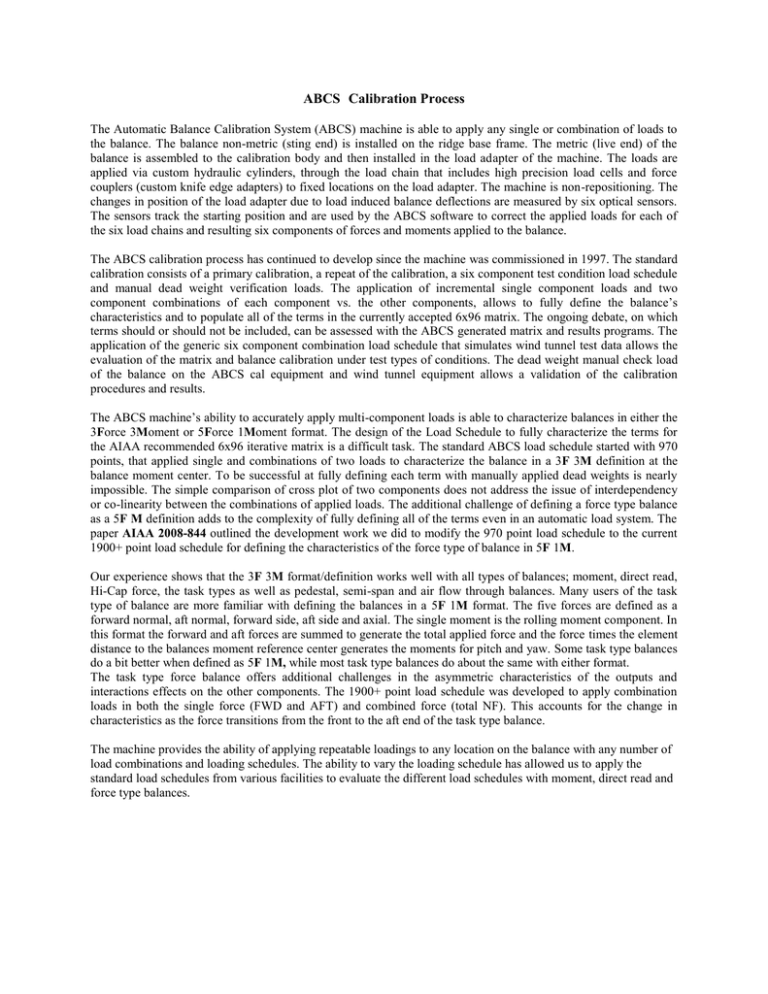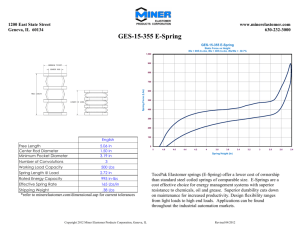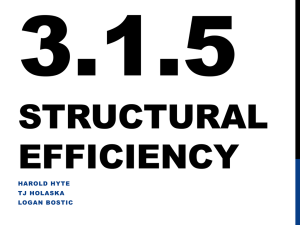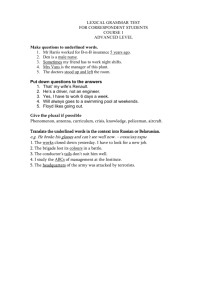ABCS Calibration Process - Triumph Force Measurement
advertisement

ABCS Calibration Process The Automatic Balance Calibration System (ABCS) machine is able to apply any single or combination of loads to the balance. The balance non-metric (sting end) is installed on the ridge base frame. The metric (live end) of the balance is assembled to the calibration body and then installed in the load adapter of the machine. The loads are applied via custom hydraulic cylinders, through the load chain that includes high precision load cells and force couplers (custom knife edge adapters) to fixed locations on the load adapter. The machine is non-repositioning. The changes in position of the load adapter due to load induced balance deflections are measured by six optical sensors. The sensors track the starting position and are used by the ABCS software to correct the applied loads for each of the six load chains and resulting six components of forces and moments applied to the balance. The ABCS calibration process has continued to develop since the machine was commissioned in 1997. The standard calibration consists of a primary calibration, a repeat of the calibration, a six component test condition load schedule and manual dead weight verification loads. The application of incremental single component loads and two component combinations of each component vs. the other components, allows to fully define the balance’s characteristics and to populate all of the terms in the currently accepted 6x96 matrix. The ongoing debate, on which terms should or should not be included, can be assessed with the ABCS generated matrix and results programs. The application of the generic six component combination load schedule that simulates wind tunnel test data allows the evaluation of the matrix and balance calibration under test types of conditions. The dead weight manual check load of the balance on the ABCS cal equipment and wind tunnel equipment allows a validation of the calibration procedures and results. The ABCS machine’s ability to accurately apply multi-component loads is able to characterize balances in either the 3Force 3Moment or 5Force 1Moment format. The design of the Load Schedule to fully characterize the terms for the AIAA recommended 6x96 iterative matrix is a difficult task. The standard ABCS load schedule started with 970 points, that applied single and combinations of two loads to characterize the balance in a 3F 3M definition at the balance moment center. To be successful at fully defining each term with manually applied dead weights is nearly impossible. The simple comparison of cross plot of two components does not address the issue of interdependency or co-linearity between the combinations of applied loads. The additional challenge of defining a force type balance as a 5F M definition adds to the complexity of fully defining all of the terms even in an automatic load system. The paper AIAA 2008-844 outlined the development work we did to modify the 970 point load schedule to the current 1900+ point load schedule for defining the characteristics of the force type of balance in 5F 1M. Our experience shows that the 3F 3M format/definition works well with all types of balances; moment, direct read, Hi-Cap force, the task types as well as pedestal, semi-span and air flow through balances. Many users of the task type of balance are more familiar with defining the balances in a 5F 1M format. The five forces are defined as a forward normal, aft normal, forward side, aft side and axial. The single moment is the rolling moment component. In this format the forward and aft forces are summed to generate the total applied force and the force times the element distance to the balances moment reference center generates the moments for pitch and yaw. Some task type balances do a bit better when defined as 5F 1M, while most task type balances do about the same with either format. The task type force balance offers additional challenges in the asymmetric characteristics of the outputs and interactions effects on the other components. The 1900+ point load schedule was developed to apply combination loads in both the single force (FWD and AFT) and combined force (total NF). This accounts for the change in characteristics as the force transitions from the front to the aft end of the task type balance. The machine provides the ability of applying repeatable loadings to any location on the balance with any number of load combinations and loading schedules. The ability to vary the loading schedule has allowed us to apply the standard load schedules from various facilities to evaluate the different load schedules with moment, direct read and force type balances. ABCS Balance Installed in Cal Body in ABCS Load Adapter ABCS Load Capacity The load capacity of the ABCS was selected to try and meet the load requirements for the majority of balance in the US inventory at the time the machine was ordered in 1996. We were not able to meet the load requirements of every balance and tried to select the load capability that would benefit most of the balances that would be able to be calibrated in the ABCS machine. Component Normal Force Pitching Moment Side Force Yawing Moment Rolling Moment Axial Force Maximum Allowable 10,000 Lbs 80,000 In-Lbs 5,000 Lbs 16,000 In-Lbs 16,000 In-Lbs 2,200 Lbs Maximum Loads to Date 10,000 Lbs 25,000 In-Lbs 5,000 Lbs 16,000 In-Lbs 18,000 In-Lbs 2,200 Lbs Low End Max Loads Used to Date 100 Lbs 200 In-Lbs 20 Lbs 60 In-Lbs 60 In-Lbs 10 Lbs The machine is able to apply very small loads for low range balances. The load cells are easily changed to match the load range of the balance. By matching the load range for each balance the machine is able to provide increased resolution and accuracy for a wide range of balances.







